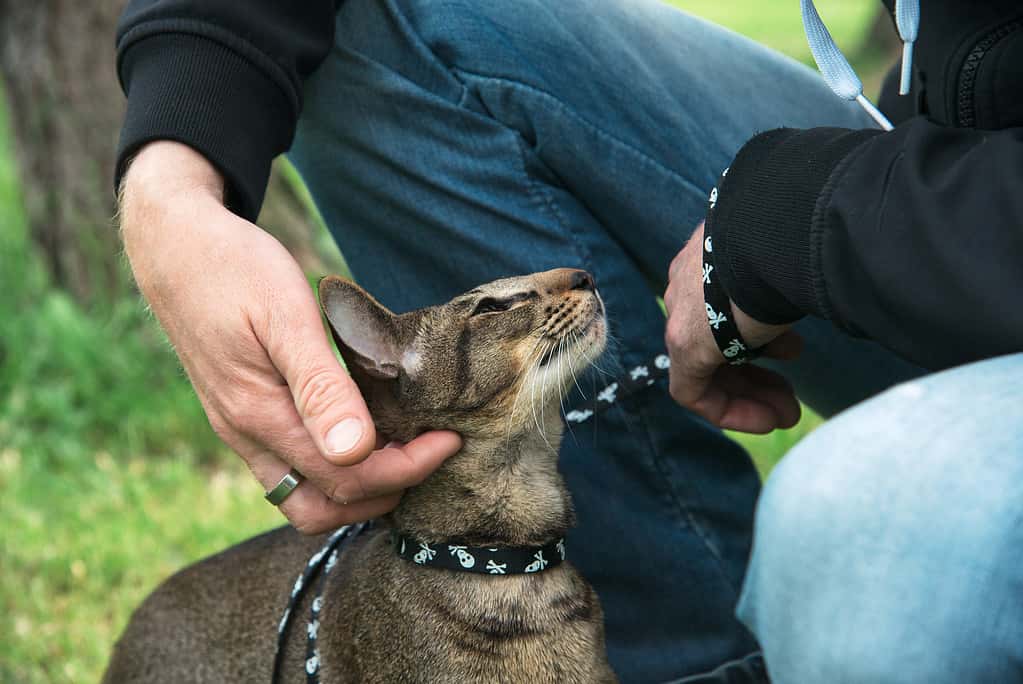Did you know that you can take your cat on walks with you? That’s right: canine companions aren’t the only pets ready to explore the world at your side. With time, you can harness train your cat, which opens a door for many new opportunities.
However, learning to harness train your cat isn’t always easy. That’s why we’ve compiled this complete guide to show you how to harness train your cat, along with tips and advice.
Ready to learn more? Keep reading below!
Before You Begin
Before you begin learning how to harness train your cat, you’ll need to make sure that you have all the necessary equipment and materials. There are many harnesses and leashes on the market. There are options available for both dogs and cats. Make sure to choose a harness that is designed to fit cats. Although they’re similar, cat and dog bodies aren’t identical, and you’ll want to pick equipment that takes this into account.
It’s also important to remember that even if your cat readily learns to walk in their harness, exploring the outdoors is a different, sometimes more difficult, step. If your cat has lived their lives completely indoors and only seen outside through a window, it can be a scary experience. As a result, after harness training your cat, you may need to take more time to get them comfortable being outdoors before planning full walks with your feline friend.

Before you begin learning how to harness train your cat, make sure to choose a harness that is designed to fit cats.
©Jeremy Bentham/Shutterstock.com
Steps to Harness Training Your Cat
Learning how to harness train your cat is a step-by-step process. Some cats will take longer on certain steps than others. The key is to be patient and learn what helps your cat learn best, just like with any trick or skill.
1. Introduce the Harness
The first step to harness training doesn’t actually involve using the harness. Instead, you’ll want to get your cat used to seeing and smelling the harness. Then, introduce the harness slowly by holding it up to your cat and letting them sniff it. If you’re able to, you can also leave it in a spot they can access for a few days, so they grow comfortable being around the harness.
This is especially useful for skittish cats that tend to jump away or hiss at anything new.
2. Reward Curiosity
As your cat grows more and more comfortable exploring the harness, make sure to reward them with treats. You can also use a clicker if you have one on hand.
The timing of the rewards is important. Make sure to only reward positive interactions, such as sticking their head into the harness, sniffing it, or other behaviors. Hissing or growling shouldn’t be punished, but make sure not to treat these reactions either.
3. Begin Letting Them Try on the Harness
Once your cat acts more comfortable around the harness and views it as a good thing, you can begin allowing them to try the harness on. At first, don’t clasp any of the buttons or snaps. Fit the harness over your cat’s head and let them get used to that sensation first, as well as the feeling of the harness touching them.
4. Put the Harness on Properly
After your cat responds positively to having the harness on them, you can begin to put it on them properly. This means snapping any of the buckles and tightening them to the appropriate size. It’s important to make sure that all buckles and snaps are tight enough to secure your cat but not tight enough to be painful.
Make sure to adjust the different aspects of the harness as well. From the legs to the collar portion to the back, get your cat used to all parts of the harness. You can also attach the leash while supervising them in order to allow them to get used to the weight, sound, and appearance of it.
5. Allow Them to Wear the Harness
If it’s safe to do so, allow your cat to wear their harness (no leash) around the house. Let your cat get used to wearing their new harness while they’re lounging, eating, and playing so it doesn’t feel as foreign or odd to them. This will also help them develop positive associations with the harness.
6. Practice Walking Your Cat Around the House
Finally, you’re ready to start walking your cat on the harness. Congratulations! Before allowing them to venture into the outside world, however, take some time to practice walking them indoors. This allows them to get used to being led by you and the leash.
It also allows you to see if there are any easy ways for your cat to slip out or escape from their harness. It is better for them to escape inside in a secure environment than outside, where they may get lost or hurt!

With time, you can harness train your cat, which opens a door for many new opportunities.
©Karpova/Shutterstock.com
Tips and Advice to Harness Train Your Cat
Now that you know how to harness train your cat, you may be looking for some more information. Below, you’ll find some tips and advice to help make training a breeze for you and your cat.
Be Patient
Not all cats are created equal. While some cats take to harnesses quickly with no problems or reservations, this isn’t true for all cats. Depending on their history and personality, training your cat may be more difficult.
Patience is the number one key to successful training, however. If your cat is nervous or unsure about the harness, they will look to you for comfort and guidance. This means that if you’re behaving in a way that shows them you’re frustrated or unhappy, they’ll respond the same way to the harness. This can slow or even halt training.
Start With a Calm Cat
A calm cat is a happy and ready-to-learn cat. If you notice that your cat is going through the zoomies or having a bad day, then it might not be the right time to introduce the harness or start training them. Instead, wait until your cat is calm, relaxed, and more receptive to instruction.
Practice Safely First
When you finally get that harness on your cat for an extended amount of time, you’ll probably want to take them outside immediately. However, until you are sure that your cat is secure and comfortable in the harness, avoid taking them outside. Instead, walk them around your home until they are prepared to handle both the harness and the outside world at the same time.
The photo featured at the top of this post is © Abi's Photos/Shutterstock.com
Thank you for reading! Have some feedback for us? Contact the AZ Animals editorial team.






